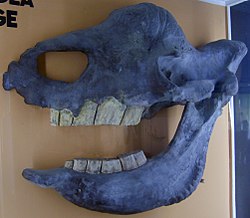Elasmotherium
|
Elasmotherium Temporal range: Late Pliocene to Late , 2.588–0.029 Ma |
|
|---|---|
 |
|
| Elasmotherium sibiricum skull cast at the Museum für Naturkunde, Berlin | |
| Scientific classification | |
| Kingdom: | Animalia |
| Phylum: | Chordata |
| Class: | Mammalia |
| Infraclass: | Eutheria |
| Order: | Perissodactyla |
| Suborder: | Ceratomorpha |
| Superfamily: | Rhinocerotoidea |
| Family: | Rhinocerotidae |
| Genus: |
†Elasmotherium J. Fischer, 1808 |
| Species | |
|
|
Elasmotherium ("Thin Plate Beast"), also known as the Giant Rhinoceros or Giant Siberian Unicorn, is an extinct genus of rhinoceros endemic to Eurasia during the Late Pliocene through the , documented from 2.6 Ma to as late as 29,000 years ago in the . Three species are recognised. The best known, E. sibiricum, was the size of a mammoth and is thought to have borne a large, thick horn on its forehead. Theories about the function of this horn include defence, attracting mates, driving away competitors, sweeping snow from the grass in winter and digging for water and plant roots. Like all rhinoceroses, elasmotheres were herbivorous. Unlike any others, its high-crowned molars were ever-growing. Its legs were longer than those of other rhinos and were adapted for galloping, giving it a horse-like gait.
The fossil received its name from Johann Fischer von Waldheim, the Dirécteur Perpétuel of the Natural History Museum, Moscow University, at a presentation before the Societé Impériale des Naturalistes in 1808. The next year in the Mémoires of the society he reported what he had said in the Programme d'invitation:
Elasmotherium is an animal with an elongated head without incisors or canines, with 5 molars on each side [made] from sinuous layers.
Then he noted on his derivation of the name:
From the Greek word ἐλασμος [elasmos], layer, to designate the layered form of the molar teeth.
All he had before him was one lower jaw donated to the museum by Yekaterina Romanovna Vorontsova-Dashkova, which he named Elasmotherium sibiricum, lamenting that it was the sole species of which he knew. The molars, the only teeth in the jaw, had formed in layers like tree rings, except the "rings", or lamellae, were highly corrugated. The edges in the grinding surface were elaborately sinuous to better break down the grasses on which the animal fed.
In March 2016, the discovery of a skull in Kazakhstan granted a new estimated time period to when Elasmotherium roamed the earth. The prior estimate was 350,000 years ago, now being reduced to 29,000 years ago.
...
Wikipedia
